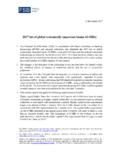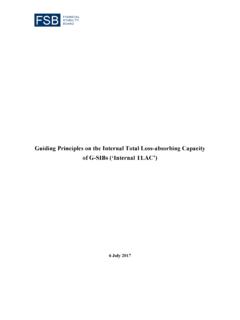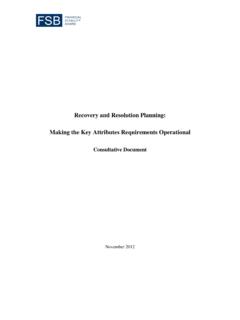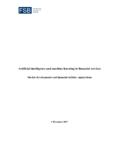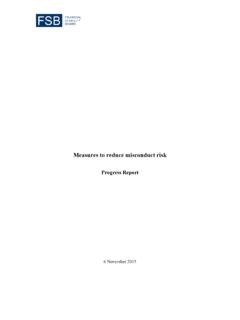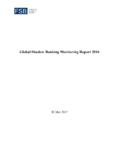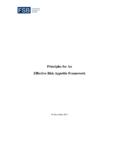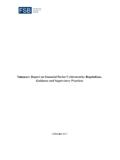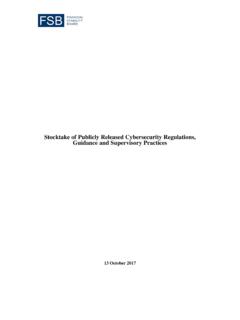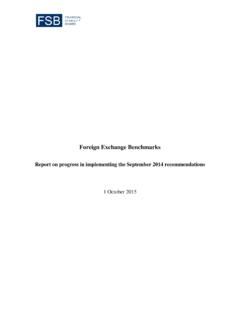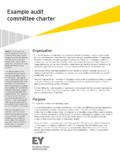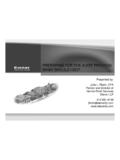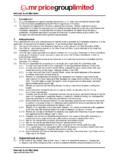Transcription of FSB Guidance on assessing risk culture - FINAL
1 Guidance on Supervisory Interaction with Financial Institutions on Risk culture A Framework for assessing Risk culture 7 April 2014 Table of Contents Page Background .. i Introduction .. 1 1. Foundational elements of a sound risk culture .. 2 2. Indicators of a sound risk culture .. 3 3. General supervisory Guidance .. 4 Tone from the top .. 5 Accountability .. 7 Effective communication and challenge .. 9 Incentives .. 9 Background Increasing the intensity and effectiveness of supervision is a key component of the Financial Stability Board s (FSB s) efforts to reduce the moral hazard posed by systemically important financial institutions (the SIFI Framework)
2 , along with requiring added capital loss absorbency and facilitating the orderly resolution of financial The FSB issued its first recommendations for enhanced supervision of financial institutions, in particular SIFIs, in October 2010, which underscored the key preconditions for effective supervision, including the need for (i) strong and unambiguous mandates; (ii) independence to act; (iii) sufficient quality and quantity of resources; and (iv) supervisors having a full suite of powers to execute on their Subsequent recommendations in 2011 and 2012 strengthened the supervisory expectations for financial institutions risk governance, internal controls and risk management functions, as well as risk data aggregation and risk reporting A number of these recommendations have been implemented and, collectively, have raised the bar for both supervisors and SIFIs.
3 This paper takes forward the recommendation set out in the November 2012 progress report for supervisors to explore ways to assess risk culture at financial institutions, particularly at The paper draws on the collective experience and efforts of supervisory and regulatory authorities across the FSB membership and insights garnered from market participants through roundtables and bilateral 1 See FSB, Reducing the moral hazard posed by systemically important financial institutions, October 2010 ( ).
4 2 See FSB, Intensity and Effectiveness of SIFI Supervision Recommendations for enhanced supervision, November 2010 ( ). 3 See FSB, Intensity and Effectiveness of SIFI Supervision Progress report on implementing the recommendations on enhanced supervision, November 2011 ); and FSB, Intensity and Effectiveness of SIFI Supervision Progress Report to the G20 Ministers and Governors, November 2012 ). The expectation is that institutions should have strong and not merely good risk management, and that high standards of risk management should be fully integrated into an institution s culture and compensation practices.
5 4 See FSB, Intensity and Effectiveness of SIFI Supervision Progress Report to the G20 Ministers and Governors, November 2012, pages 3-4 ( ). 5 The FSB Supervisory Intensity and Effectiveness (SIE) group held a roundtable on risk culture with board members, risk committee chairs and chief risk officers of banks and insurers and had discussions with the Group of Thirty (which in 2013 published the paper A New Paradigm: Financial Institution Boards and Supervisors), KPMG, and McKinsey & Company, Tapestry on their respective work in this area.
6 In addition, members of the SIE participated in the July 2013 IIF Symposium on Supervision which focused on risk culture at financial institutions. Selected research was also considered such as that relating to safety culture . 1 Introduction Increasing the intensity and effectiveness of supervision is a key pillar of the FSB s efforts to reduce the risks posed by systemically important financial institutions (SIFIs). A more intense and effective approach to oversight aims to deliver pre-emptive, rather than reactive, outcomes-based supervision.
7 An anticipatory and strategic approach to supervision rests, among other things, on the ability to engage in high-level sceptical conversations with the board and senior management on the financial institution s risk appetite framework, and whether the institution s risk culture supports adherence to the board-approved risk appetite. culture can be a very complex issue as it involves behaviours and attitudes. But efforts should be made by financial institutions and by supervisors to understand an institution s culture and how it affects safety and soundness.
8 While various definitions of culture exist, supervisors are focusing on the institution s norms, attitudes and behaviours related to risk awareness, risk taking and risk management, or the institution s risk Weaknesses in risk culture are often considered a root cause of the global financial crisis, headline risk and compliance events. A financial institution s risk culture plays an important role in influencing the actions and decisions taken by individuals within the institution and in shaping the institution s attitude toward its stakeholders, including its supervisors.
9 A sound risk culture consistently supports appropriate risk awareness, behaviours and judgements about risk-taking within a strong risk governance framework. A sound risk culture bolsters effective risk management, promotes sound risk-taking, and ensures that emerging risks or risk-taking activities beyond the institution s risk appetite are recognised, assessed, escalated and addressed in a timely manner. A sound risk culture should emphasise throughout the institution the importance of ensuring that: (i) an appropriate risk-reward balance consistent with the institution s risk appetite is achieved when taking on risks ; (ii) an effective system of controls commensurate with the scale and complexity of the financial institution is properly put in place.
10 (iii) the quality of risk models, data accuracy, capability of available tools to accurately measure risks , and justifications for risk taking can be challenged, and (iv) all limit breaches, deviations from established policies, and operational incidents are thoroughly followed up with proportionate disciplinary actions when necessary. Risk culture , as well as corporate culture , evolves over time in relation to the events that affect the institution s history (such as mergers and acquisitions) and to the external context within which the institution operates.
